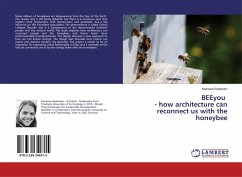Today millions of honeybees are disappearing from the face of the Earth. The reason why is still being debated, but there is a consensus view that modern food production, with monoculture and pesticides, has a big influence on the honeybee population. The phenomenon is called Colony Collapse Disorder and is a consequence of the disconnection between people and the natural world. This book explores how architecture can reconnect people and the honeybee, and hence foster more environmentally friendly behavior. The design discusses a new approach to how we can inspire change. The design also discusses how nature can inspire and improve modern city planning. The project is meant to be an inspiration for expanding urban beekeeping in Oslo, and a reminder of the natural connection we as human beings share with the honeybees.
Bitte wählen Sie Ihr Anliegen aus.
Rechnungen
Retourenschein anfordern
Bestellstatus
Storno








